Health and Safety Leadership Essentials - Importance of Leadership in NHS, London
VerifiedAdded on 2023/06/08
|15
|5609
|362
AI Summary
The report is based on the importance of leadership in health and safety in context with national health services (NHS), London. The report includes literature review including critiques and current situations on leading health and safety within an organisation, mainly in context with NHS. The report aims on building strategies for effective leadership practices for promoting health and workplace safety.
Contribute Materials
Your contribution can guide someone’s learning journey. Share your
documents today.
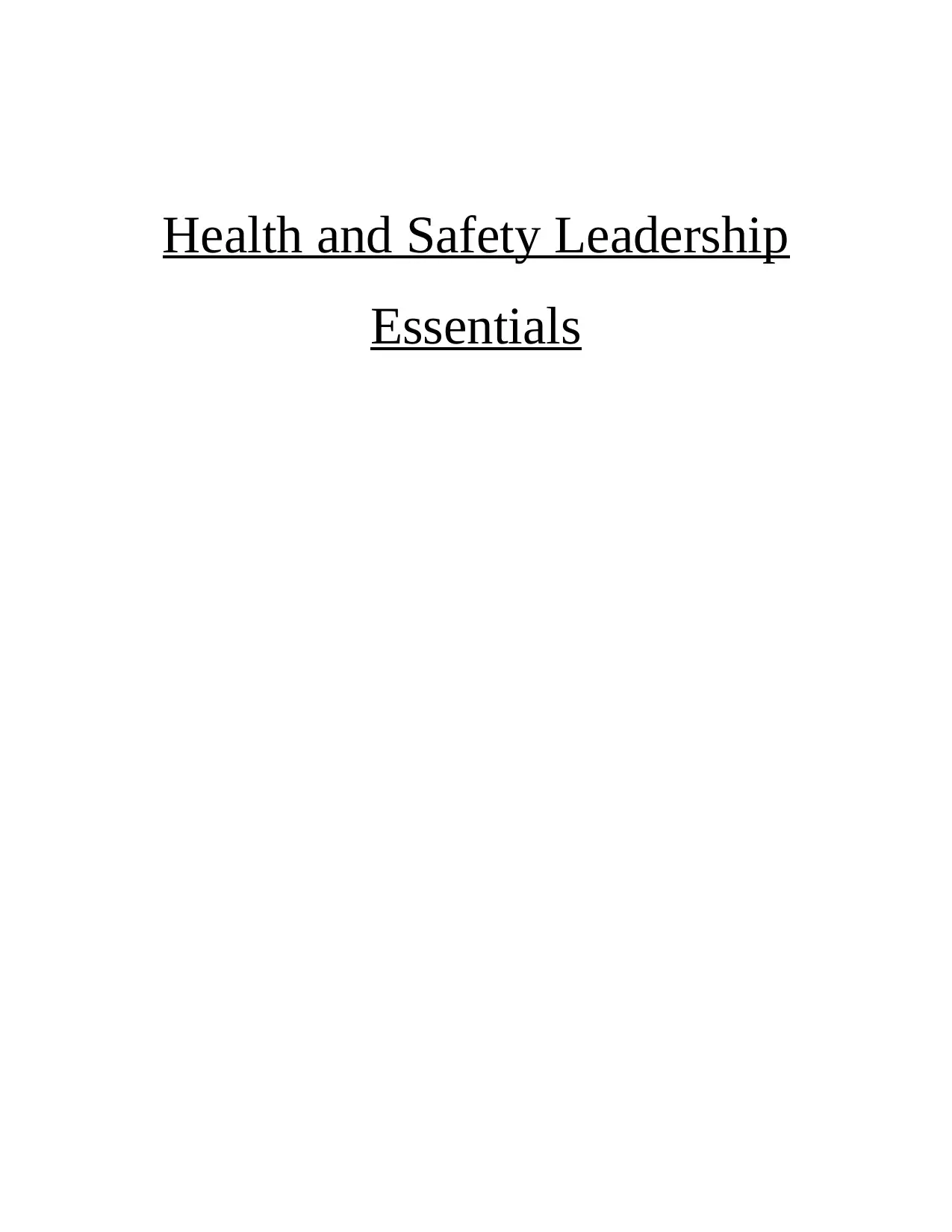
Health and Safety Leadership
Essentials
Essentials
Secure Best Marks with AI Grader
Need help grading? Try our AI Grader for instant feedback on your assignments.
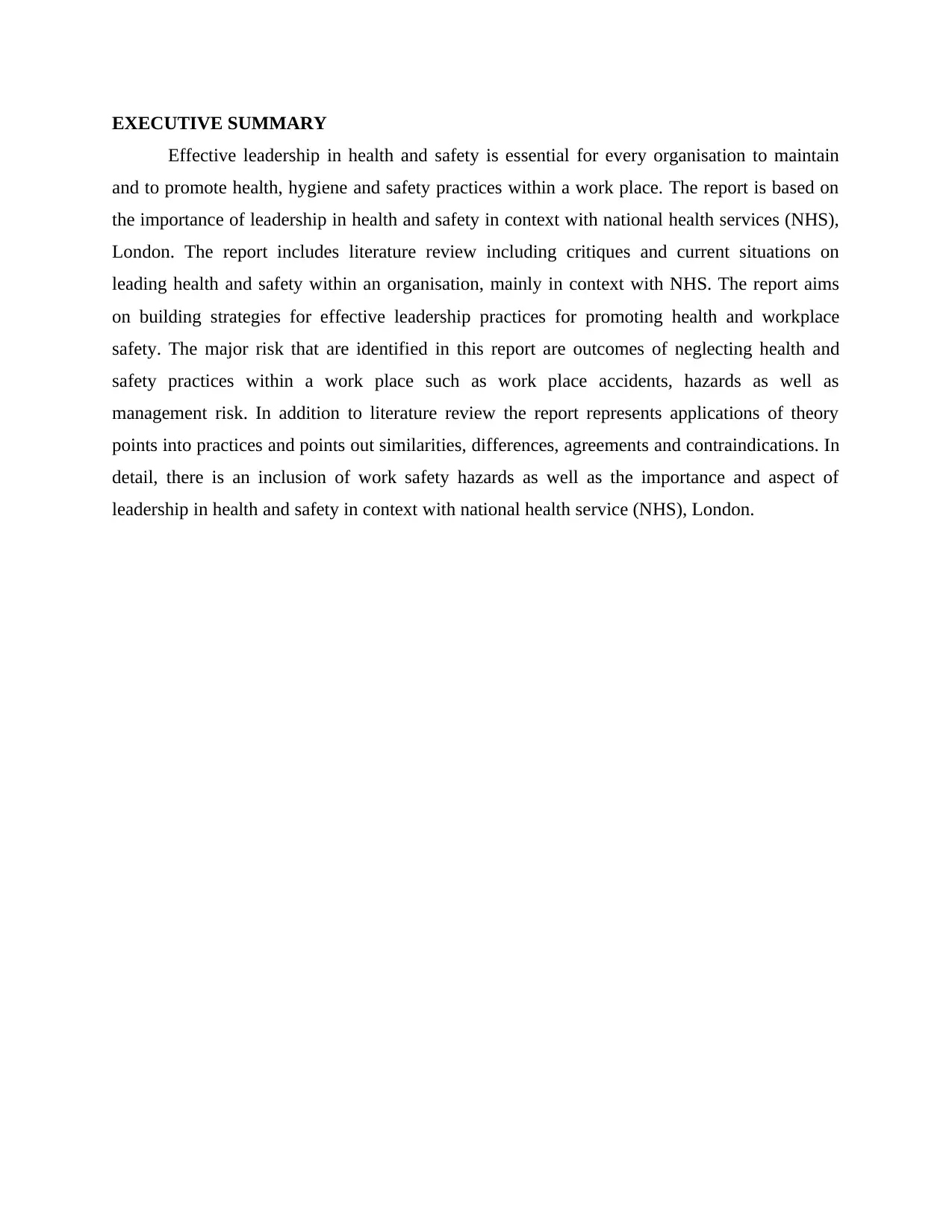
EXECUTIVE SUMMARY
Effective leadership in health and safety is essential for every organisation to maintain
and to promote health, hygiene and safety practices within a work place. The report is based on
the importance of leadership in health and safety in context with national health services (NHS),
London. The report includes literature review including critiques and current situations on
leading health and safety within an organisation, mainly in context with NHS. The report aims
on building strategies for effective leadership practices for promoting health and workplace
safety. The major risk that are identified in this report are outcomes of neglecting health and
safety practices within a work place such as work place accidents, hazards as well as
management risk. In addition to literature review the report represents applications of theory
points into practices and points out similarities, differences, agreements and contraindications. In
detail, there is an inclusion of work safety hazards as well as the importance and aspect of
leadership in health and safety in context with national health service (NHS), London.
Effective leadership in health and safety is essential for every organisation to maintain
and to promote health, hygiene and safety practices within a work place. The report is based on
the importance of leadership in health and safety in context with national health services (NHS),
London. The report includes literature review including critiques and current situations on
leading health and safety within an organisation, mainly in context with NHS. The report aims
on building strategies for effective leadership practices for promoting health and workplace
safety. The major risk that are identified in this report are outcomes of neglecting health and
safety practices within a work place such as work place accidents, hazards as well as
management risk. In addition to literature review the report represents applications of theory
points into practices and points out similarities, differences, agreements and contraindications. In
detail, there is an inclusion of work safety hazards as well as the importance and aspect of
leadership in health and safety in context with national health service (NHS), London.

Table of Content.
INTRODUCTION...........................................................................................................................3
LITERATURE REVIEW................................................................................................................3
Current issues in leading health and safety at work in context to NHS.......................................3
Challenges on health and safety practices employed by NHS and role of leadership in
improving health and safety practices..........................................................................................5
APPLICATION OF THEORY TO PRACTICE.............................................................................7
Evaluation of health and safety leadership styles applied in NHS..............................................7
Contingency leadership models of path goal theory in relevance with health and safety
leadership in NHS........................................................................................................................8
Evaluation of impact of team cohesiveness, team structure and dynamics as essential elements
to lead health and safety at work..................................................................................................9
LEGAL AND QUALITY IMPLICATION...................................................................................10
Legal body responsible for health and safety regulation within the country of head-quarters of
NHS............................................................................................................................................10
Quality based challenges that are faced by authorities in implementation of effective health
and safety policies......................................................................................................................11
Effective measures which can be undertaken for improving current state of health safety
policies for corporate in country of head-quarters of NHS........................................................11
CONCLUSIONS AND RECOMMENDATION..........................................................................12
REFERENCES..............................................................................................................................13
2
INTRODUCTION...........................................................................................................................3
LITERATURE REVIEW................................................................................................................3
Current issues in leading health and safety at work in context to NHS.......................................3
Challenges on health and safety practices employed by NHS and role of leadership in
improving health and safety practices..........................................................................................5
APPLICATION OF THEORY TO PRACTICE.............................................................................7
Evaluation of health and safety leadership styles applied in NHS..............................................7
Contingency leadership models of path goal theory in relevance with health and safety
leadership in NHS........................................................................................................................8
Evaluation of impact of team cohesiveness, team structure and dynamics as essential elements
to lead health and safety at work..................................................................................................9
LEGAL AND QUALITY IMPLICATION...................................................................................10
Legal body responsible for health and safety regulation within the country of head-quarters of
NHS............................................................................................................................................10
Quality based challenges that are faced by authorities in implementation of effective health
and safety policies......................................................................................................................11
Effective measures which can be undertaken for improving current state of health safety
policies for corporate in country of head-quarters of NHS........................................................11
CONCLUSIONS AND RECOMMENDATION..........................................................................12
REFERENCES..............................................................................................................................13
2
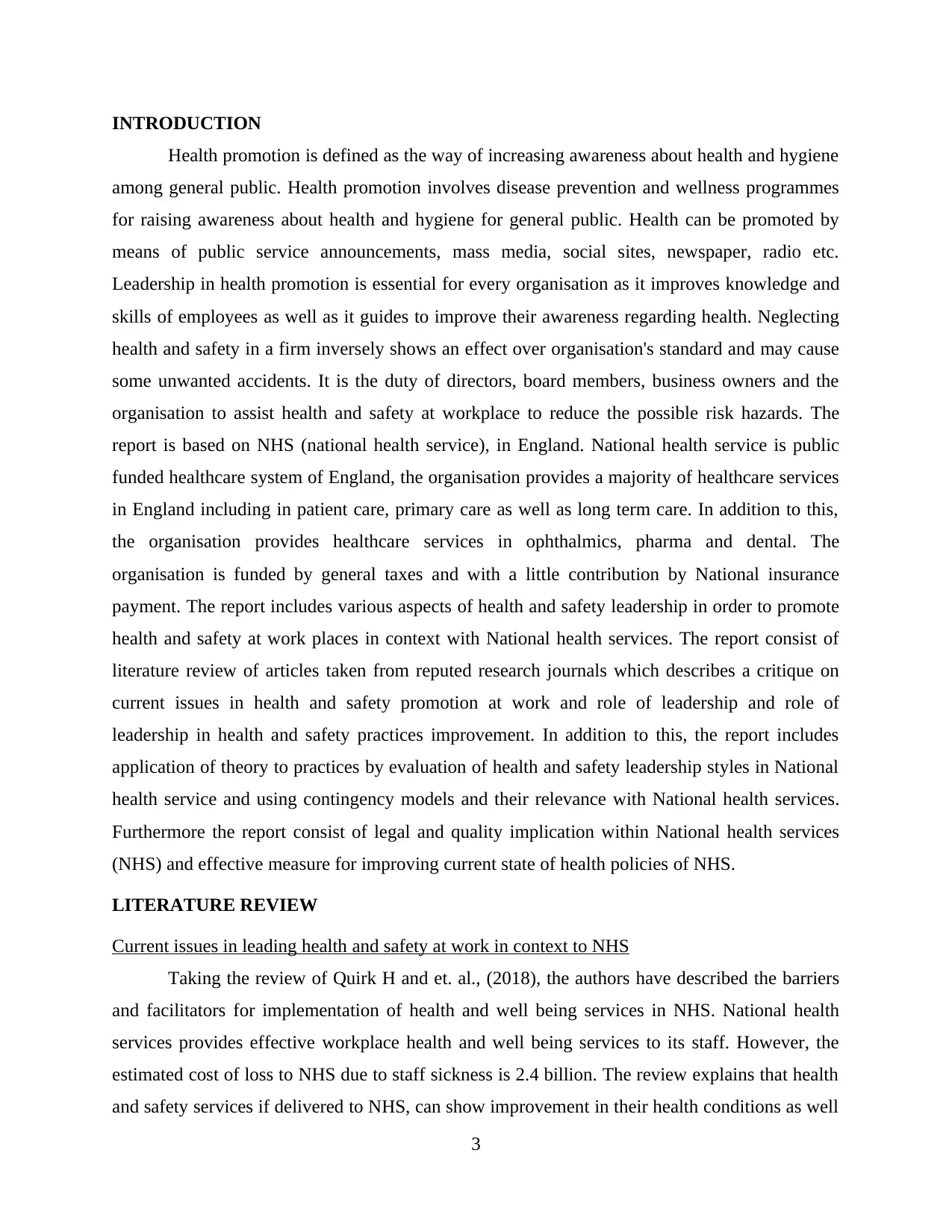
INTRODUCTION
Health promotion is defined as the way of increasing awareness about health and hygiene
among general public. Health promotion involves disease prevention and wellness programmes
for raising awareness about health and hygiene for general public. Health can be promoted by
means of public service announcements, mass media, social sites, newspaper, radio etc.
Leadership in health promotion is essential for every organisation as it improves knowledge and
skills of employees as well as it guides to improve their awareness regarding health. Neglecting
health and safety in a firm inversely shows an effect over organisation's standard and may cause
some unwanted accidents. It is the duty of directors, board members, business owners and the
organisation to assist health and safety at workplace to reduce the possible risk hazards. The
report is based on NHS (national health service), in England. National health service is public
funded healthcare system of England, the organisation provides a majority of healthcare services
in England including in patient care, primary care as well as long term care. In addition to this,
the organisation provides healthcare services in ophthalmics, pharma and dental. The
organisation is funded by general taxes and with a little contribution by National insurance
payment. The report includes various aspects of health and safety leadership in order to promote
health and safety at work places in context with National health services. The report consist of
literature review of articles taken from reputed research journals which describes a critique on
current issues in health and safety promotion at work and role of leadership and role of
leadership in health and safety practices improvement. In addition to this, the report includes
application of theory to practices by evaluation of health and safety leadership styles in National
health service and using contingency models and their relevance with National health services.
Furthermore the report consist of legal and quality implication within National health services
(NHS) and effective measure for improving current state of health policies of NHS.
LITERATURE REVIEW
Current issues in leading health and safety at work in context to NHS
Taking the review of Quirk H and et. al., (2018), the authors have described the barriers
and facilitators for implementation of health and well being services in NHS. National health
services provides effective workplace health and well being services to its staff. However, the
estimated cost of loss to NHS due to staff sickness is 2.4 billion. The review explains that health
and safety services if delivered to NHS, can show improvement in their health conditions as well
3
Health promotion is defined as the way of increasing awareness about health and hygiene
among general public. Health promotion involves disease prevention and wellness programmes
for raising awareness about health and hygiene for general public. Health can be promoted by
means of public service announcements, mass media, social sites, newspaper, radio etc.
Leadership in health promotion is essential for every organisation as it improves knowledge and
skills of employees as well as it guides to improve their awareness regarding health. Neglecting
health and safety in a firm inversely shows an effect over organisation's standard and may cause
some unwanted accidents. It is the duty of directors, board members, business owners and the
organisation to assist health and safety at workplace to reduce the possible risk hazards. The
report is based on NHS (national health service), in England. National health service is public
funded healthcare system of England, the organisation provides a majority of healthcare services
in England including in patient care, primary care as well as long term care. In addition to this,
the organisation provides healthcare services in ophthalmics, pharma and dental. The
organisation is funded by general taxes and with a little contribution by National insurance
payment. The report includes various aspects of health and safety leadership in order to promote
health and safety at work places in context with National health services. The report consist of
literature review of articles taken from reputed research journals which describes a critique on
current issues in health and safety promotion at work and role of leadership and role of
leadership in health and safety practices improvement. In addition to this, the report includes
application of theory to practices by evaluation of health and safety leadership styles in National
health service and using contingency models and their relevance with National health services.
Furthermore the report consist of legal and quality implication within National health services
(NHS) and effective measure for improving current state of health policies of NHS.
LITERATURE REVIEW
Current issues in leading health and safety at work in context to NHS
Taking the review of Quirk H and et. al., (2018), the authors have described the barriers
and facilitators for implementation of health and well being services in NHS. National health
services provides effective workplace health and well being services to its staff. However, the
estimated cost of loss to NHS due to staff sickness is 2.4 billion. The review explains that health
and safety services if delivered to NHS, can show improvement in their health conditions as well
3
Secure Best Marks with AI Grader
Need help grading? Try our AI Grader for instant feedback on your assignments.

as in their productivity. Still there are some issues in leading the health and safety at workplace.
The authors have taken interview of NHS staff, among which four were senior leaders, four were
head of the department and three were health practitioners in a region of united kingdom.
Interview of all was analysed via thematic analysis. The review further described that NHS in the
2014 Commonwealth fund report was reported to be ranked for best health care system in world
in terms of quality of care, efficiency and low cost. The data analysis of review suggested that
issues in leading health and safety services within NHS are busy and pressurised environment
due to shortage of staff, financial issues, priorities of upper management. Barriers that were
found in engagement of staff with health and safety services within NHS were due to nature of
work and dependency on audience. The study overall examined that there is a need of
improvement within mental as well as physical health of healthcare professional and staff of
NHS to eliminate or treat the rising issues in health and safe practices. The barrier for
implementing health and safety hazards are from front line issues and financial barriers. The
findings of review suggested that there was a required need of culture which supports health and
safety in NHS (Quirk, Crank, Carter, Leahy, and Copeland, 2018).
Another article review by Gallagher C and Underhill E, suggested management for work
health and safety within a workplace. As per the review of authors, the occupational health and
safety requires effective management and a significant advancement for dealing with
organisation's risk. The authors suggested that changing nature of employment and practices
within the organisation which contribute significantly in identification as well as control of risk
associated with work place. Such issues are leading cause for failure of safety and health
hazards. The regulation will also prevent injuries that are relevant with work and ill health.
Alongside, the organisation's structure as well as the services are responsible for workplace
related safety hazards. It is an employer's duty to identify risk and plan an assessment as well as
prevention guide for it. Participation of workers, their representative as well as competent
personnel's assistance is required for effective management of health and safety practices in a
workplace, especially like NHS. The report suggested that there are large number of obstacles
and issues in leading health and safety within a workplace like NHS, the challenges outlined are:
Employment nature, structure of organisation, errors in medication, errors in surgery and
laboratory as well as testing. A lack in employment is observed in NHS, which increases the
work load on employees. Work load pressure is responsible for mental health of employees as
4
The authors have taken interview of NHS staff, among which four were senior leaders, four were
head of the department and three were health practitioners in a region of united kingdom.
Interview of all was analysed via thematic analysis. The review further described that NHS in the
2014 Commonwealth fund report was reported to be ranked for best health care system in world
in terms of quality of care, efficiency and low cost. The data analysis of review suggested that
issues in leading health and safety services within NHS are busy and pressurised environment
due to shortage of staff, financial issues, priorities of upper management. Barriers that were
found in engagement of staff with health and safety services within NHS were due to nature of
work and dependency on audience. The study overall examined that there is a need of
improvement within mental as well as physical health of healthcare professional and staff of
NHS to eliminate or treat the rising issues in health and safe practices. The barrier for
implementing health and safety hazards are from front line issues and financial barriers. The
findings of review suggested that there was a required need of culture which supports health and
safety in NHS (Quirk, Crank, Carter, Leahy, and Copeland, 2018).
Another article review by Gallagher C and Underhill E, suggested management for work
health and safety within a workplace. As per the review of authors, the occupational health and
safety requires effective management and a significant advancement for dealing with
organisation's risk. The authors suggested that changing nature of employment and practices
within the organisation which contribute significantly in identification as well as control of risk
associated with work place. Such issues are leading cause for failure of safety and health
hazards. The regulation will also prevent injuries that are relevant with work and ill health.
Alongside, the organisation's structure as well as the services are responsible for workplace
related safety hazards. It is an employer's duty to identify risk and plan an assessment as well as
prevention guide for it. Participation of workers, their representative as well as competent
personnel's assistance is required for effective management of health and safety practices in a
workplace, especially like NHS. The report suggested that there are large number of obstacles
and issues in leading health and safety within a workplace like NHS, the challenges outlined are:
Employment nature, structure of organisation, errors in medication, errors in surgery and
laboratory as well as testing. A lack in employment is observed in NHS, which increases the
work load on employees. Work load pressure is responsible for mental health of employees as
4
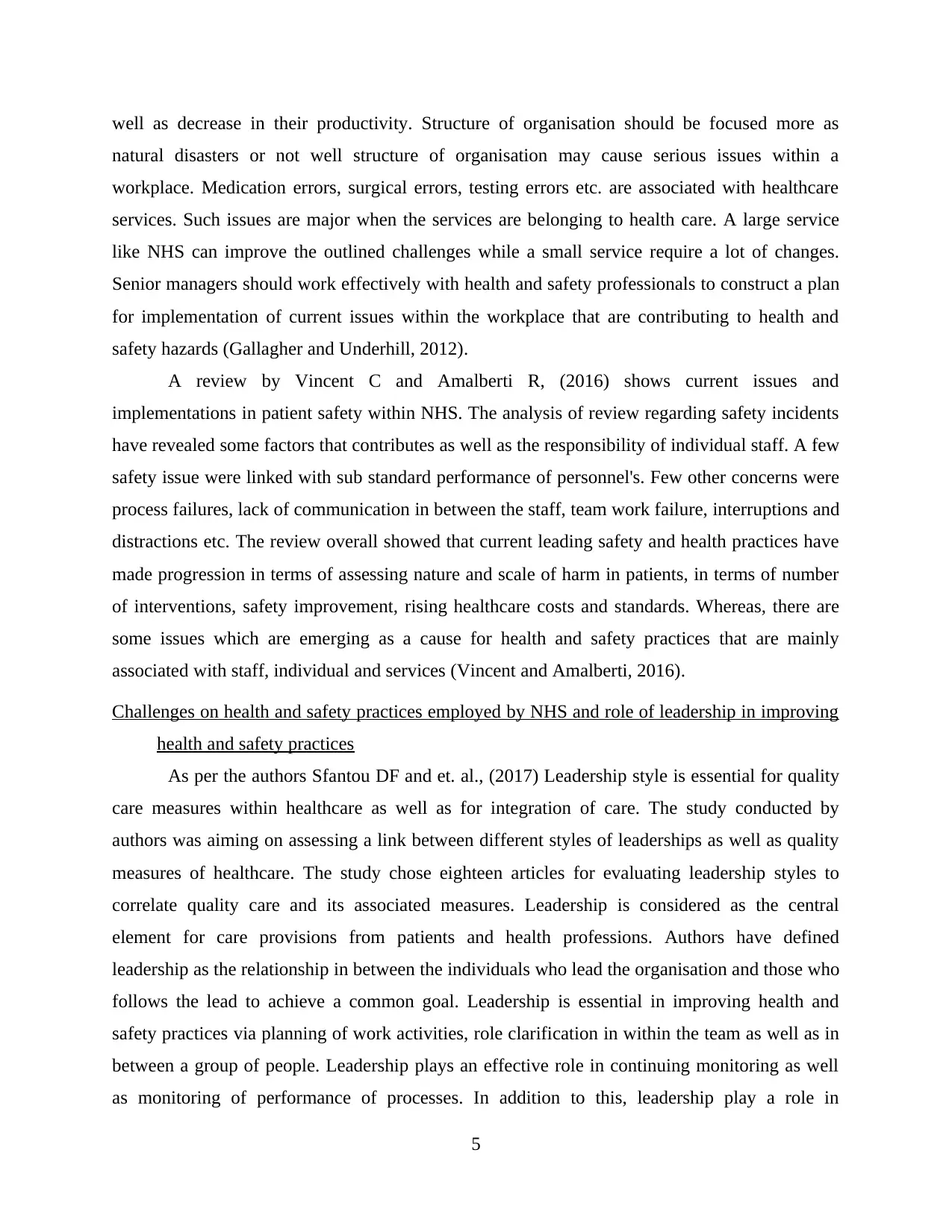
well as decrease in their productivity. Structure of organisation should be focused more as
natural disasters or not well structure of organisation may cause serious issues within a
workplace. Medication errors, surgical errors, testing errors etc. are associated with healthcare
services. Such issues are major when the services are belonging to health care. A large service
like NHS can improve the outlined challenges while a small service require a lot of changes.
Senior managers should work effectively with health and safety professionals to construct a plan
for implementation of current issues within the workplace that are contributing to health and
safety hazards (Gallagher and Underhill, 2012).
A review by Vincent C and Amalberti R, (2016) shows current issues and
implementations in patient safety within NHS. The analysis of review regarding safety incidents
have revealed some factors that contributes as well as the responsibility of individual staff. A few
safety issue were linked with sub standard performance of personnel's. Few other concerns were
process failures, lack of communication in between the staff, team work failure, interruptions and
distractions etc. The review overall showed that current leading safety and health practices have
made progression in terms of assessing nature and scale of harm in patients, in terms of number
of interventions, safety improvement, rising healthcare costs and standards. Whereas, there are
some issues which are emerging as a cause for health and safety practices that are mainly
associated with staff, individual and services (Vincent and Amalberti, 2016).
Challenges on health and safety practices employed by NHS and role of leadership in improving
health and safety practices
As per the authors Sfantou DF and et. al., (2017) Leadership style is essential for quality
care measures within healthcare as well as for integration of care. The study conducted by
authors was aiming on assessing a link between different styles of leaderships as well as quality
measures of healthcare. The study chose eighteen articles for evaluating leadership styles to
correlate quality care and its associated measures. Leadership is considered as the central
element for care provisions from patients and health professions. Authors have defined
leadership as the relationship in between the individuals who lead the organisation and those who
follows the lead to achieve a common goal. Leadership is essential in improving health and
safety practices via planning of work activities, role clarification in within the team as well as in
between a group of people. Leadership plays an effective role in continuing monitoring as well
as monitoring of performance of processes. In addition to this, leadership play a role in
5
natural disasters or not well structure of organisation may cause serious issues within a
workplace. Medication errors, surgical errors, testing errors etc. are associated with healthcare
services. Such issues are major when the services are belonging to health care. A large service
like NHS can improve the outlined challenges while a small service require a lot of changes.
Senior managers should work effectively with health and safety professionals to construct a plan
for implementation of current issues within the workplace that are contributing to health and
safety hazards (Gallagher and Underhill, 2012).
A review by Vincent C and Amalberti R, (2016) shows current issues and
implementations in patient safety within NHS. The analysis of review regarding safety incidents
have revealed some factors that contributes as well as the responsibility of individual staff. A few
safety issue were linked with sub standard performance of personnel's. Few other concerns were
process failures, lack of communication in between the staff, team work failure, interruptions and
distractions etc. The review overall showed that current leading safety and health practices have
made progression in terms of assessing nature and scale of harm in patients, in terms of number
of interventions, safety improvement, rising healthcare costs and standards. Whereas, there are
some issues which are emerging as a cause for health and safety practices that are mainly
associated with staff, individual and services (Vincent and Amalberti, 2016).
Challenges on health and safety practices employed by NHS and role of leadership in improving
health and safety practices
As per the authors Sfantou DF and et. al., (2017) Leadership style is essential for quality
care measures within healthcare as well as for integration of care. The study conducted by
authors was aiming on assessing a link between different styles of leaderships as well as quality
measures of healthcare. The study chose eighteen articles for evaluating leadership styles to
correlate quality care and its associated measures. Leadership is considered as the central
element for care provisions from patients and health professions. Authors have defined
leadership as the relationship in between the individuals who lead the organisation and those who
follows the lead to achieve a common goal. Leadership is essential in improving health and
safety practices via planning of work activities, role clarification in within the team as well as in
between a group of people. Leadership plays an effective role in continuing monitoring as well
as monitoring of performance of processes. In addition to this, leadership play a role in
5
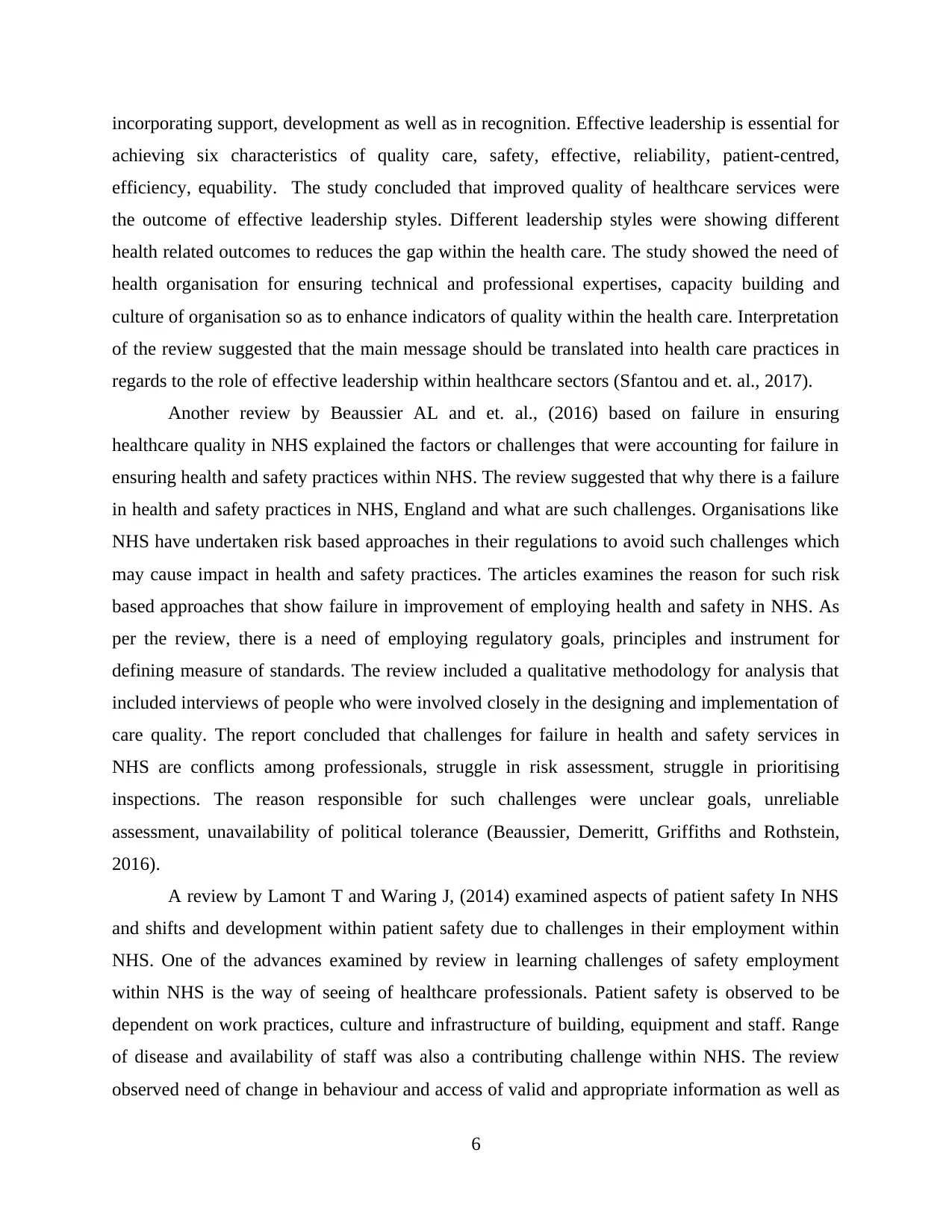
incorporating support, development as well as in recognition. Effective leadership is essential for
achieving six characteristics of quality care, safety, effective, reliability, patient-centred,
efficiency, equability. The study concluded that improved quality of healthcare services were
the outcome of effective leadership styles. Different leadership styles were showing different
health related outcomes to reduces the gap within the health care. The study showed the need of
health organisation for ensuring technical and professional expertises, capacity building and
culture of organisation so as to enhance indicators of quality within the health care. Interpretation
of the review suggested that the main message should be translated into health care practices in
regards to the role of effective leadership within healthcare sectors (Sfantou and et. al., 2017).
Another review by Beaussier AL and et. al., (2016) based on failure in ensuring
healthcare quality in NHS explained the factors or challenges that were accounting for failure in
ensuring health and safety practices within NHS. The review suggested that why there is a failure
in health and safety practices in NHS, England and what are such challenges. Organisations like
NHS have undertaken risk based approaches in their regulations to avoid such challenges which
may cause impact in health and safety practices. The articles examines the reason for such risk
based approaches that show failure in improvement of employing health and safety in NHS. As
per the review, there is a need of employing regulatory goals, principles and instrument for
defining measure of standards. The review included a qualitative methodology for analysis that
included interviews of people who were involved closely in the designing and implementation of
care quality. The report concluded that challenges for failure in health and safety services in
NHS are conflicts among professionals, struggle in risk assessment, struggle in prioritising
inspections. The reason responsible for such challenges were unclear goals, unreliable
assessment, unavailability of political tolerance (Beaussier, Demeritt, Griffiths and Rothstein,
2016).
A review by Lamont T and Waring J, (2014) examined aspects of patient safety In NHS
and shifts and development within patient safety due to challenges in their employment within
NHS. One of the advances examined by review in learning challenges of safety employment
within NHS is the way of seeing of healthcare professionals. Patient safety is observed to be
dependent on work practices, culture and infrastructure of building, equipment and staff. Range
of disease and availability of staff was also a contributing challenge within NHS. The review
observed need of change in behaviour and access of valid and appropriate information as well as
6
achieving six characteristics of quality care, safety, effective, reliability, patient-centred,
efficiency, equability. The study concluded that improved quality of healthcare services were
the outcome of effective leadership styles. Different leadership styles were showing different
health related outcomes to reduces the gap within the health care. The study showed the need of
health organisation for ensuring technical and professional expertises, capacity building and
culture of organisation so as to enhance indicators of quality within the health care. Interpretation
of the review suggested that the main message should be translated into health care practices in
regards to the role of effective leadership within healthcare sectors (Sfantou and et. al., 2017).
Another review by Beaussier AL and et. al., (2016) based on failure in ensuring
healthcare quality in NHS explained the factors or challenges that were accounting for failure in
ensuring health and safety practices within NHS. The review suggested that why there is a failure
in health and safety practices in NHS, England and what are such challenges. Organisations like
NHS have undertaken risk based approaches in their regulations to avoid such challenges which
may cause impact in health and safety practices. The articles examines the reason for such risk
based approaches that show failure in improvement of employing health and safety in NHS. As
per the review, there is a need of employing regulatory goals, principles and instrument for
defining measure of standards. The review included a qualitative methodology for analysis that
included interviews of people who were involved closely in the designing and implementation of
care quality. The report concluded that challenges for failure in health and safety services in
NHS are conflicts among professionals, struggle in risk assessment, struggle in prioritising
inspections. The reason responsible for such challenges were unclear goals, unreliable
assessment, unavailability of political tolerance (Beaussier, Demeritt, Griffiths and Rothstein,
2016).
A review by Lamont T and Waring J, (2014) examined aspects of patient safety In NHS
and shifts and development within patient safety due to challenges in their employment within
NHS. One of the advances examined by review in learning challenges of safety employment
within NHS is the way of seeing of healthcare professionals. Patient safety is observed to be
dependent on work practices, culture and infrastructure of building, equipment and staff. Range
of disease and availability of staff was also a contributing challenge within NHS. The review
observed need of change in behaviour and access of valid and appropriate information as well as
6
Paraphrase This Document
Need a fresh take? Get an instant paraphrase of this document with our AI Paraphraser
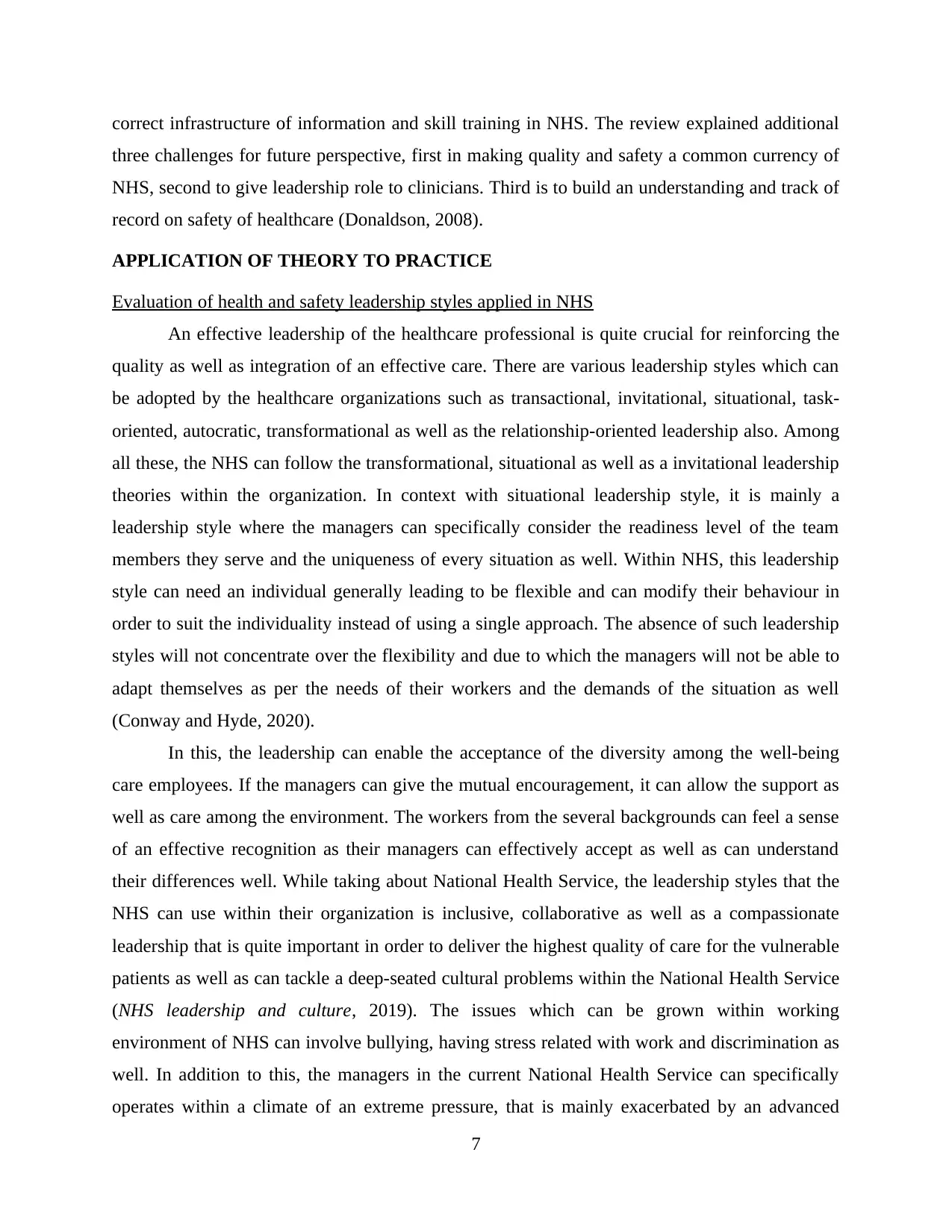
correct infrastructure of information and skill training in NHS. The review explained additional
three challenges for future perspective, first in making quality and safety a common currency of
NHS, second to give leadership role to clinicians. Third is to build an understanding and track of
record on safety of healthcare (Donaldson, 2008).
APPLICATION OF THEORY TO PRACTICE
Evaluation of health and safety leadership styles applied in NHS
An effective leadership of the healthcare professional is quite crucial for reinforcing the
quality as well as integration of an effective care. There are various leadership styles which can
be adopted by the healthcare organizations such as transactional, invitational, situational, task-
oriented, autocratic, transformational as well as the relationship-oriented leadership also. Among
all these, the NHS can follow the transformational, situational as well as a invitational leadership
theories within the organization. In context with situational leadership style, it is mainly a
leadership style where the managers can specifically consider the readiness level of the team
members they serve and the uniqueness of every situation as well. Within NHS, this leadership
style can need an individual generally leading to be flexible and can modify their behaviour in
order to suit the individuality instead of using a single approach. The absence of such leadership
styles will not concentrate over the flexibility and due to which the managers will not be able to
adapt themselves as per the needs of their workers and the demands of the situation as well
(Conway and Hyde, 2020).
In this, the leadership can enable the acceptance of the diversity among the well-being
care employees. If the managers can give the mutual encouragement, it can allow the support as
well as care among the environment. The workers from the several backgrounds can feel a sense
of an effective recognition as their managers can effectively accept as well as can understand
their differences well. While taking about National Health Service, the leadership styles that the
NHS can use within their organization is inclusive, collaborative as well as a compassionate
leadership that is quite important in order to deliver the highest quality of care for the vulnerable
patients as well as can tackle a deep-seated cultural problems within the National Health Service
(NHS leadership and culture, 2019). The issues which can be grown within working
environment of NHS can involve bullying, having stress related with work and discrimination as
well. In addition to this, the managers in the current National Health Service can specifically
operates within a climate of an extreme pressure, that is mainly exacerbated by an advanced
7
three challenges for future perspective, first in making quality and safety a common currency of
NHS, second to give leadership role to clinicians. Third is to build an understanding and track of
record on safety of healthcare (Donaldson, 2008).
APPLICATION OF THEORY TO PRACTICE
Evaluation of health and safety leadership styles applied in NHS
An effective leadership of the healthcare professional is quite crucial for reinforcing the
quality as well as integration of an effective care. There are various leadership styles which can
be adopted by the healthcare organizations such as transactional, invitational, situational, task-
oriented, autocratic, transformational as well as the relationship-oriented leadership also. Among
all these, the NHS can follow the transformational, situational as well as a invitational leadership
theories within the organization. In context with situational leadership style, it is mainly a
leadership style where the managers can specifically consider the readiness level of the team
members they serve and the uniqueness of every situation as well. Within NHS, this leadership
style can need an individual generally leading to be flexible and can modify their behaviour in
order to suit the individuality instead of using a single approach. The absence of such leadership
styles will not concentrate over the flexibility and due to which the managers will not be able to
adapt themselves as per the needs of their workers and the demands of the situation as well
(Conway and Hyde, 2020).
In this, the leadership can enable the acceptance of the diversity among the well-being
care employees. If the managers can give the mutual encouragement, it can allow the support as
well as care among the environment. The workers from the several backgrounds can feel a sense
of an effective recognition as their managers can effectively accept as well as can understand
their differences well. While taking about National Health Service, the leadership styles that the
NHS can use within their organization is inclusive, collaborative as well as a compassionate
leadership that is quite important in order to deliver the highest quality of care for the vulnerable
patients as well as can tackle a deep-seated cultural problems within the National Health Service
(NHS leadership and culture, 2019). The issues which can be grown within working
environment of NHS can involve bullying, having stress related with work and discrimination as
well. In addition to this, the managers in the current National Health Service can specifically
operates within a climate of an extreme pressure, that is mainly exacerbated by an advanced
7
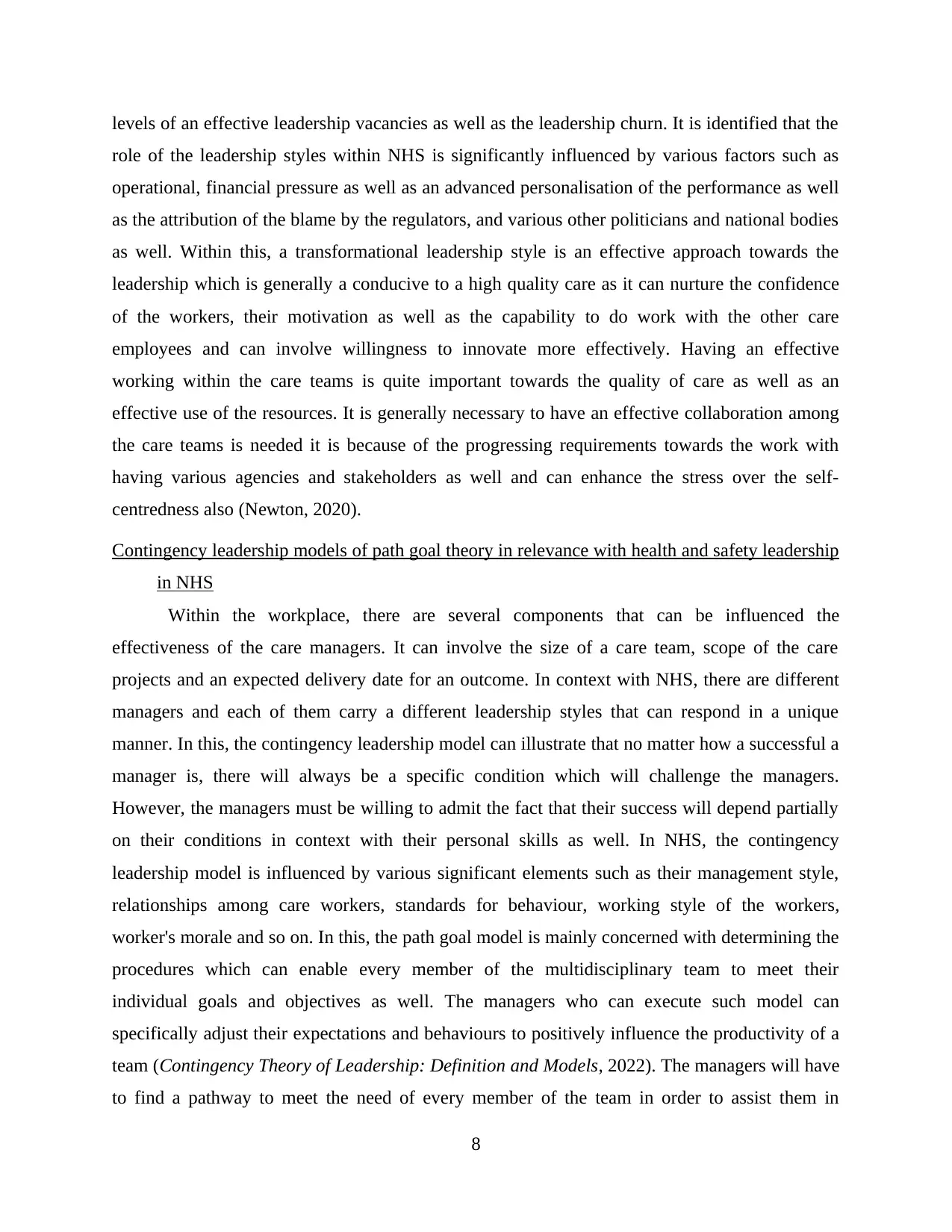
levels of an effective leadership vacancies as well as the leadership churn. It is identified that the
role of the leadership styles within NHS is significantly influenced by various factors such as
operational, financial pressure as well as an advanced personalisation of the performance as well
as the attribution of the blame by the regulators, and various other politicians and national bodies
as well. Within this, a transformational leadership style is an effective approach towards the
leadership which is generally a conducive to a high quality care as it can nurture the confidence
of the workers, their motivation as well as the capability to do work with the other care
employees and can involve willingness to innovate more effectively. Having an effective
working within the care teams is quite important towards the quality of care as well as an
effective use of the resources. It is generally necessary to have an effective collaboration among
the care teams is needed it is because of the progressing requirements towards the work with
having various agencies and stakeholders as well and can enhance the stress over the self-
centredness also (Newton, 2020).
Contingency leadership models of path goal theory in relevance with health and safety leadership
in NHS
Within the workplace, there are several components that can be influenced the
effectiveness of the care managers. It can involve the size of a care team, scope of the care
projects and an expected delivery date for an outcome. In context with NHS, there are different
managers and each of them carry a different leadership styles that can respond in a unique
manner. In this, the contingency leadership model can illustrate that no matter how a successful a
manager is, there will always be a specific condition which will challenge the managers.
However, the managers must be willing to admit the fact that their success will depend partially
on their conditions in context with their personal skills as well. In NHS, the contingency
leadership model is influenced by various significant elements such as their management style,
relationships among care workers, standards for behaviour, working style of the workers,
worker's morale and so on. In this, the path goal model is mainly concerned with determining the
procedures which can enable every member of the multidisciplinary team to meet their
individual goals and objectives as well. The managers who can execute such model can
specifically adjust their expectations and behaviours to positively influence the productivity of a
team (Contingency Theory of Leadership: Definition and Models, 2022). The managers will have
to find a pathway to meet the need of every member of the team in order to assist them in
8
role of the leadership styles within NHS is significantly influenced by various factors such as
operational, financial pressure as well as an advanced personalisation of the performance as well
as the attribution of the blame by the regulators, and various other politicians and national bodies
as well. Within this, a transformational leadership style is an effective approach towards the
leadership which is generally a conducive to a high quality care as it can nurture the confidence
of the workers, their motivation as well as the capability to do work with the other care
employees and can involve willingness to innovate more effectively. Having an effective
working within the care teams is quite important towards the quality of care as well as an
effective use of the resources. It is generally necessary to have an effective collaboration among
the care teams is needed it is because of the progressing requirements towards the work with
having various agencies and stakeholders as well and can enhance the stress over the self-
centredness also (Newton, 2020).
Contingency leadership models of path goal theory in relevance with health and safety leadership
in NHS
Within the workplace, there are several components that can be influenced the
effectiveness of the care managers. It can involve the size of a care team, scope of the care
projects and an expected delivery date for an outcome. In context with NHS, there are different
managers and each of them carry a different leadership styles that can respond in a unique
manner. In this, the contingency leadership model can illustrate that no matter how a successful a
manager is, there will always be a specific condition which will challenge the managers.
However, the managers must be willing to admit the fact that their success will depend partially
on their conditions in context with their personal skills as well. In NHS, the contingency
leadership model is influenced by various significant elements such as their management style,
relationships among care workers, standards for behaviour, working style of the workers,
worker's morale and so on. In this, the path goal model is mainly concerned with determining the
procedures which can enable every member of the multidisciplinary team to meet their
individual goals and objectives as well. The managers who can execute such model can
specifically adjust their expectations and behaviours to positively influence the productivity of a
team (Contingency Theory of Leadership: Definition and Models, 2022). The managers will have
to find a pathway to meet the need of every member of the team in order to assist them in
8
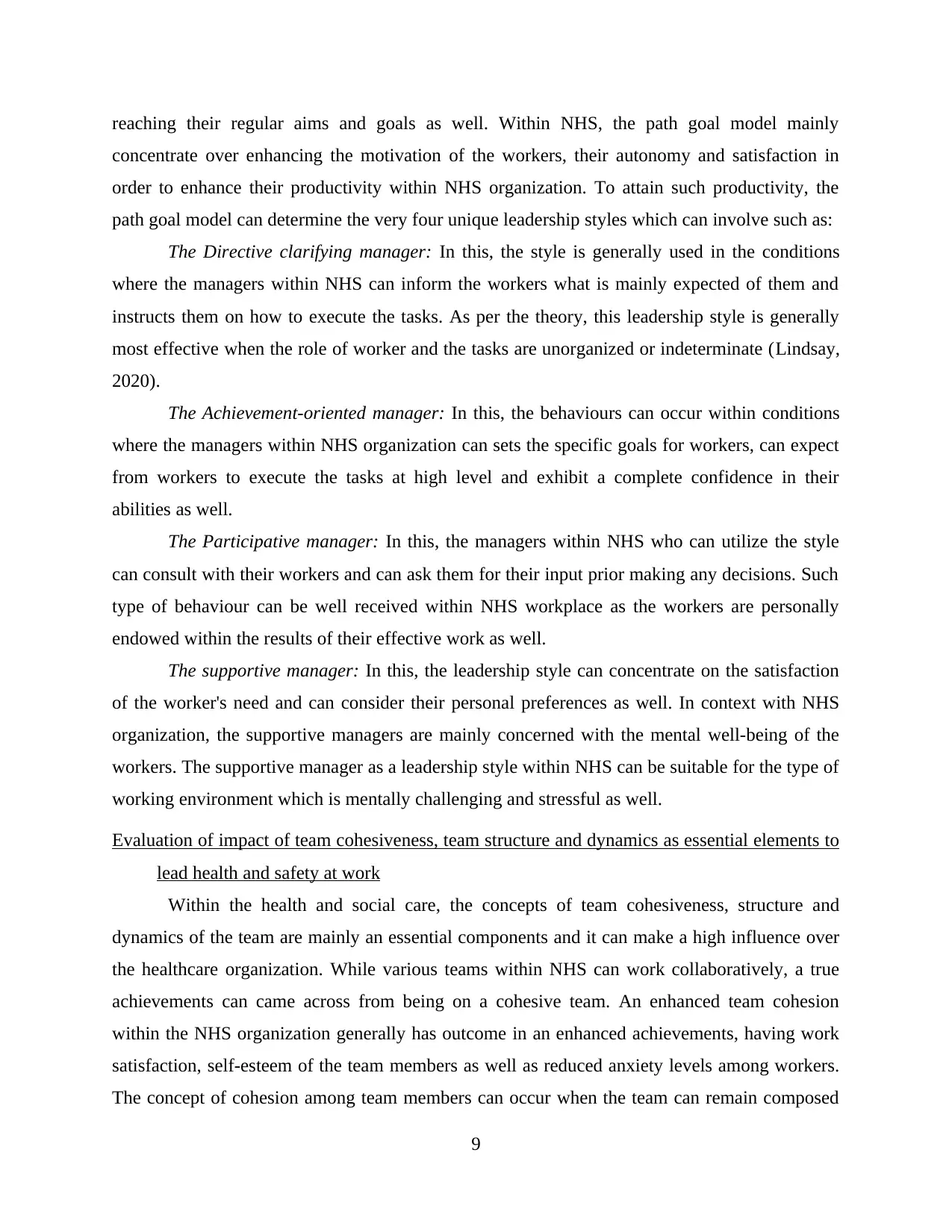
reaching their regular aims and goals as well. Within NHS, the path goal model mainly
concentrate over enhancing the motivation of the workers, their autonomy and satisfaction in
order to enhance their productivity within NHS organization. To attain such productivity, the
path goal model can determine the very four unique leadership styles which can involve such as:
The Directive clarifying manager: In this, the style is generally used in the conditions
where the managers within NHS can inform the workers what is mainly expected of them and
instructs them on how to execute the tasks. As per the theory, this leadership style is generally
most effective when the role of worker and the tasks are unorganized or indeterminate (Lindsay,
2020).
The Achievement-oriented manager: In this, the behaviours can occur within conditions
where the managers within NHS organization can sets the specific goals for workers, can expect
from workers to execute the tasks at high level and exhibit a complete confidence in their
abilities as well.
The Participative manager: In this, the managers within NHS who can utilize the style
can consult with their workers and can ask them for their input prior making any decisions. Such
type of behaviour can be well received within NHS workplace as the workers are personally
endowed within the results of their effective work as well.
The supportive manager: In this, the leadership style can concentrate on the satisfaction
of the worker's need and can consider their personal preferences as well. In context with NHS
organization, the supportive managers are mainly concerned with the mental well-being of the
workers. The supportive manager as a leadership style within NHS can be suitable for the type of
working environment which is mentally challenging and stressful as well.
Evaluation of impact of team cohesiveness, team structure and dynamics as essential elements to
lead health and safety at work
Within the health and social care, the concepts of team cohesiveness, structure and
dynamics of the team are mainly an essential components and it can make a high influence over
the healthcare organization. While various teams within NHS can work collaboratively, a true
achievements can came across from being on a cohesive team. An enhanced team cohesion
within the NHS organization generally has outcome in an enhanced achievements, having work
satisfaction, self-esteem of the team members as well as reduced anxiety levels among workers.
The concept of cohesion among team members can occur when the team can remain composed
9
concentrate over enhancing the motivation of the workers, their autonomy and satisfaction in
order to enhance their productivity within NHS organization. To attain such productivity, the
path goal model can determine the very four unique leadership styles which can involve such as:
The Directive clarifying manager: In this, the style is generally used in the conditions
where the managers within NHS can inform the workers what is mainly expected of them and
instructs them on how to execute the tasks. As per the theory, this leadership style is generally
most effective when the role of worker and the tasks are unorganized or indeterminate (Lindsay,
2020).
The Achievement-oriented manager: In this, the behaviours can occur within conditions
where the managers within NHS organization can sets the specific goals for workers, can expect
from workers to execute the tasks at high level and exhibit a complete confidence in their
abilities as well.
The Participative manager: In this, the managers within NHS who can utilize the style
can consult with their workers and can ask them for their input prior making any decisions. Such
type of behaviour can be well received within NHS workplace as the workers are personally
endowed within the results of their effective work as well.
The supportive manager: In this, the leadership style can concentrate on the satisfaction
of the worker's need and can consider their personal preferences as well. In context with NHS
organization, the supportive managers are mainly concerned with the mental well-being of the
workers. The supportive manager as a leadership style within NHS can be suitable for the type of
working environment which is mentally challenging and stressful as well.
Evaluation of impact of team cohesiveness, team structure and dynamics as essential elements to
lead health and safety at work
Within the health and social care, the concepts of team cohesiveness, structure and
dynamics of the team are mainly an essential components and it can make a high influence over
the healthcare organization. While various teams within NHS can work collaboratively, a true
achievements can came across from being on a cohesive team. An enhanced team cohesion
within the NHS organization generally has outcome in an enhanced achievements, having work
satisfaction, self-esteem of the team members as well as reduced anxiety levels among workers.
The concept of cohesion among team members can occur when the team can remain composed
9
Secure Best Marks with AI Grader
Need help grading? Try our AI Grader for instant feedback on your assignments.
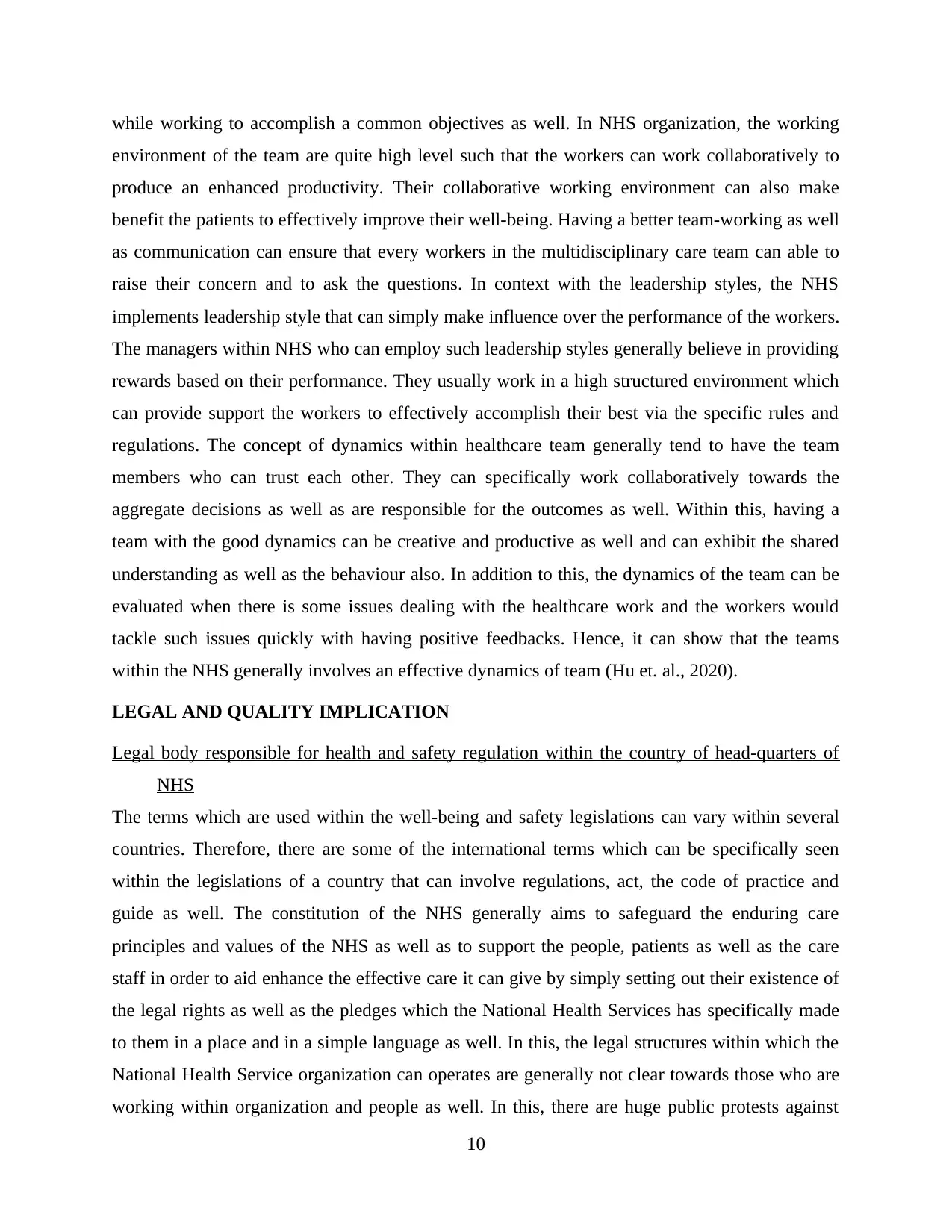
while working to accomplish a common objectives as well. In NHS organization, the working
environment of the team are quite high level such that the workers can work collaboratively to
produce an enhanced productivity. Their collaborative working environment can also make
benefit the patients to effectively improve their well-being. Having a better team-working as well
as communication can ensure that every workers in the multidisciplinary care team can able to
raise their concern and to ask the questions. In context with the leadership styles, the NHS
implements leadership style that can simply make influence over the performance of the workers.
The managers within NHS who can employ such leadership styles generally believe in providing
rewards based on their performance. They usually work in a high structured environment which
can provide support the workers to effectively accomplish their best via the specific rules and
regulations. The concept of dynamics within healthcare team generally tend to have the team
members who can trust each other. They can specifically work collaboratively towards the
aggregate decisions as well as are responsible for the outcomes as well. Within this, having a
team with the good dynamics can be creative and productive as well and can exhibit the shared
understanding as well as the behaviour also. In addition to this, the dynamics of the team can be
evaluated when there is some issues dealing with the healthcare work and the workers would
tackle such issues quickly with having positive feedbacks. Hence, it can show that the teams
within the NHS generally involves an effective dynamics of team (Hu et. al., 2020).
LEGAL AND QUALITY IMPLICATION
Legal body responsible for health and safety regulation within the country of head-quarters of
NHS
The terms which are used within the well-being and safety legislations can vary within several
countries. Therefore, there are some of the international terms which can be specifically seen
within the legislations of a country that can involve regulations, act, the code of practice and
guide as well. The constitution of the NHS generally aims to safeguard the enduring care
principles and values of the NHS as well as to support the people, patients as well as the care
staff in order to aid enhance the effective care it can give by simply setting out their existence of
the legal rights as well as the pledges which the National Health Services has specifically made
to them in a place and in a simple language as well. In this, the legal structures within which the
National Health Service organization can operates are generally not clear towards those who are
working within organization and people as well. In this, there are huge public protests against
10
environment of the team are quite high level such that the workers can work collaboratively to
produce an enhanced productivity. Their collaborative working environment can also make
benefit the patients to effectively improve their well-being. Having a better team-working as well
as communication can ensure that every workers in the multidisciplinary care team can able to
raise their concern and to ask the questions. In context with the leadership styles, the NHS
implements leadership style that can simply make influence over the performance of the workers.
The managers within NHS who can employ such leadership styles generally believe in providing
rewards based on their performance. They usually work in a high structured environment which
can provide support the workers to effectively accomplish their best via the specific rules and
regulations. The concept of dynamics within healthcare team generally tend to have the team
members who can trust each other. They can specifically work collaboratively towards the
aggregate decisions as well as are responsible for the outcomes as well. Within this, having a
team with the good dynamics can be creative and productive as well and can exhibit the shared
understanding as well as the behaviour also. In addition to this, the dynamics of the team can be
evaluated when there is some issues dealing with the healthcare work and the workers would
tackle such issues quickly with having positive feedbacks. Hence, it can show that the teams
within the NHS generally involves an effective dynamics of team (Hu et. al., 2020).
LEGAL AND QUALITY IMPLICATION
Legal body responsible for health and safety regulation within the country of head-quarters of
NHS
The terms which are used within the well-being and safety legislations can vary within several
countries. Therefore, there are some of the international terms which can be specifically seen
within the legislations of a country that can involve regulations, act, the code of practice and
guide as well. The constitution of the NHS generally aims to safeguard the enduring care
principles and values of the NHS as well as to support the people, patients as well as the care
staff in order to aid enhance the effective care it can give by simply setting out their existence of
the legal rights as well as the pledges which the National Health Services has specifically made
to them in a place and in a simple language as well. In this, the legal structures within which the
National Health Service organization can operates are generally not clear towards those who are
working within organization and people as well. In this, there are huge public protests against
10
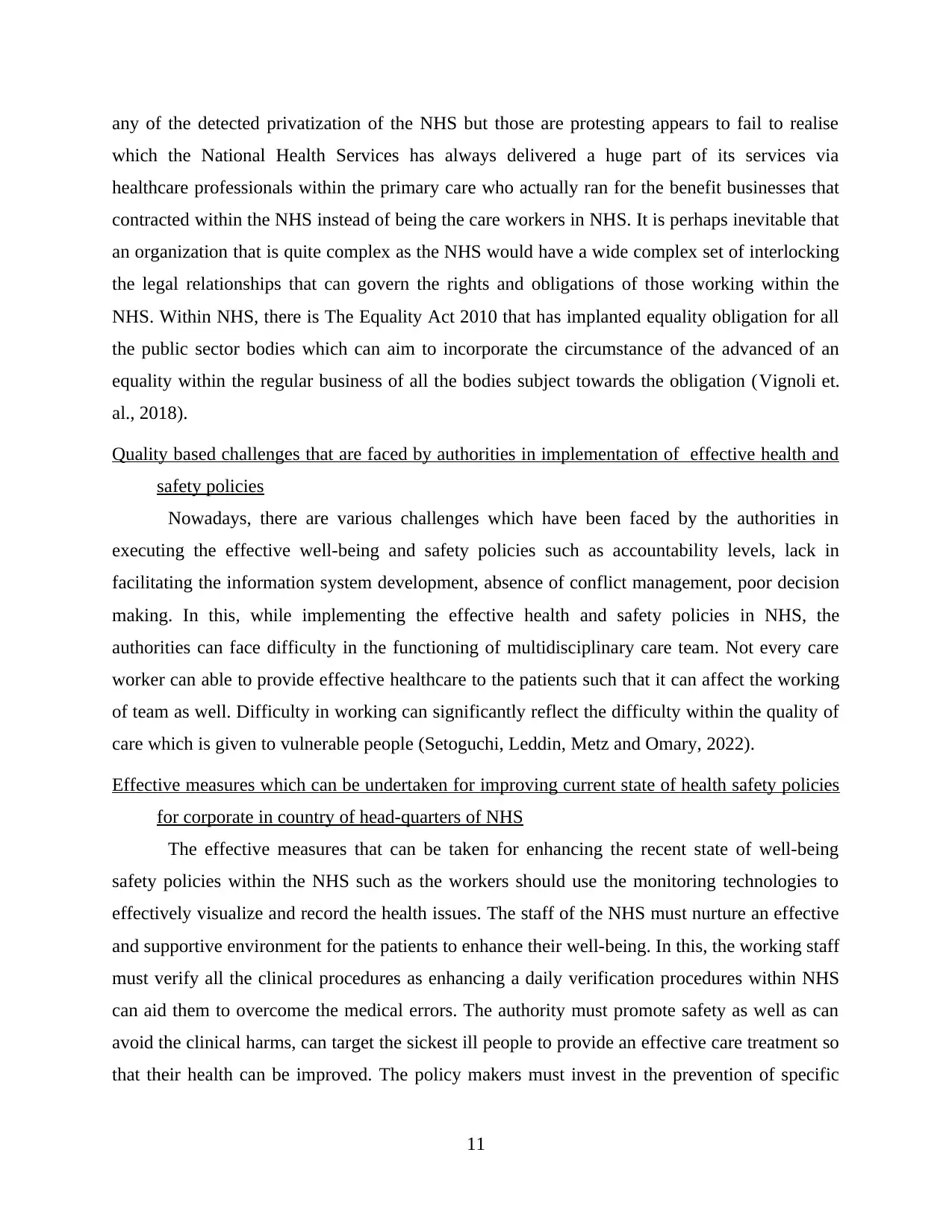
any of the detected privatization of the NHS but those are protesting appears to fail to realise
which the National Health Services has always delivered a huge part of its services via
healthcare professionals within the primary care who actually ran for the benefit businesses that
contracted within the NHS instead of being the care workers in NHS. It is perhaps inevitable that
an organization that is quite complex as the NHS would have a wide complex set of interlocking
the legal relationships that can govern the rights and obligations of those working within the
NHS. Within NHS, there is The Equality Act 2010 that has implanted equality obligation for all
the public sector bodies which can aim to incorporate the circumstance of the advanced of an
equality within the regular business of all the bodies subject towards the obligation (Vignoli et.
al., 2018).
Quality based challenges that are faced by authorities in implementation of effective health and
safety policies
Nowadays, there are various challenges which have been faced by the authorities in
executing the effective well-being and safety policies such as accountability levels, lack in
facilitating the information system development, absence of conflict management, poor decision
making. In this, while implementing the effective health and safety policies in NHS, the
authorities can face difficulty in the functioning of multidisciplinary care team. Not every care
worker can able to provide effective healthcare to the patients such that it can affect the working
of team as well. Difficulty in working can significantly reflect the difficulty within the quality of
care which is given to vulnerable people (Setoguchi, Leddin, Metz and Omary, 2022).
Effective measures which can be undertaken for improving current state of health safety policies
for corporate in country of head-quarters of NHS
The effective measures that can be taken for enhancing the recent state of well-being
safety policies within the NHS such as the workers should use the monitoring technologies to
effectively visualize and record the health issues. The staff of the NHS must nurture an effective
and supportive environment for the patients to enhance their well-being. In this, the working staff
must verify all the clinical procedures as enhancing a daily verification procedures within NHS
can aid them to overcome the medical errors. The authority must promote safety as well as can
avoid the clinical harms, can target the sickest ill people to provide an effective care treatment so
that their health can be improved. The policy makers must invest in the prevention of specific
11
which the National Health Services has always delivered a huge part of its services via
healthcare professionals within the primary care who actually ran for the benefit businesses that
contracted within the NHS instead of being the care workers in NHS. It is perhaps inevitable that
an organization that is quite complex as the NHS would have a wide complex set of interlocking
the legal relationships that can govern the rights and obligations of those working within the
NHS. Within NHS, there is The Equality Act 2010 that has implanted equality obligation for all
the public sector bodies which can aim to incorporate the circumstance of the advanced of an
equality within the regular business of all the bodies subject towards the obligation (Vignoli et.
al., 2018).
Quality based challenges that are faced by authorities in implementation of effective health and
safety policies
Nowadays, there are various challenges which have been faced by the authorities in
executing the effective well-being and safety policies such as accountability levels, lack in
facilitating the information system development, absence of conflict management, poor decision
making. In this, while implementing the effective health and safety policies in NHS, the
authorities can face difficulty in the functioning of multidisciplinary care team. Not every care
worker can able to provide effective healthcare to the patients such that it can affect the working
of team as well. Difficulty in working can significantly reflect the difficulty within the quality of
care which is given to vulnerable people (Setoguchi, Leddin, Metz and Omary, 2022).
Effective measures which can be undertaken for improving current state of health safety policies
for corporate in country of head-quarters of NHS
The effective measures that can be taken for enhancing the recent state of well-being
safety policies within the NHS such as the workers should use the monitoring technologies to
effectively visualize and record the health issues. The staff of the NHS must nurture an effective
and supportive environment for the patients to enhance their well-being. In this, the working staff
must verify all the clinical procedures as enhancing a daily verification procedures within NHS
can aid them to overcome the medical errors. The authority must promote safety as well as can
avoid the clinical harms, can target the sickest ill people to provide an effective care treatment so
that their health can be improved. The policy makers must invest in the prevention of specific
11
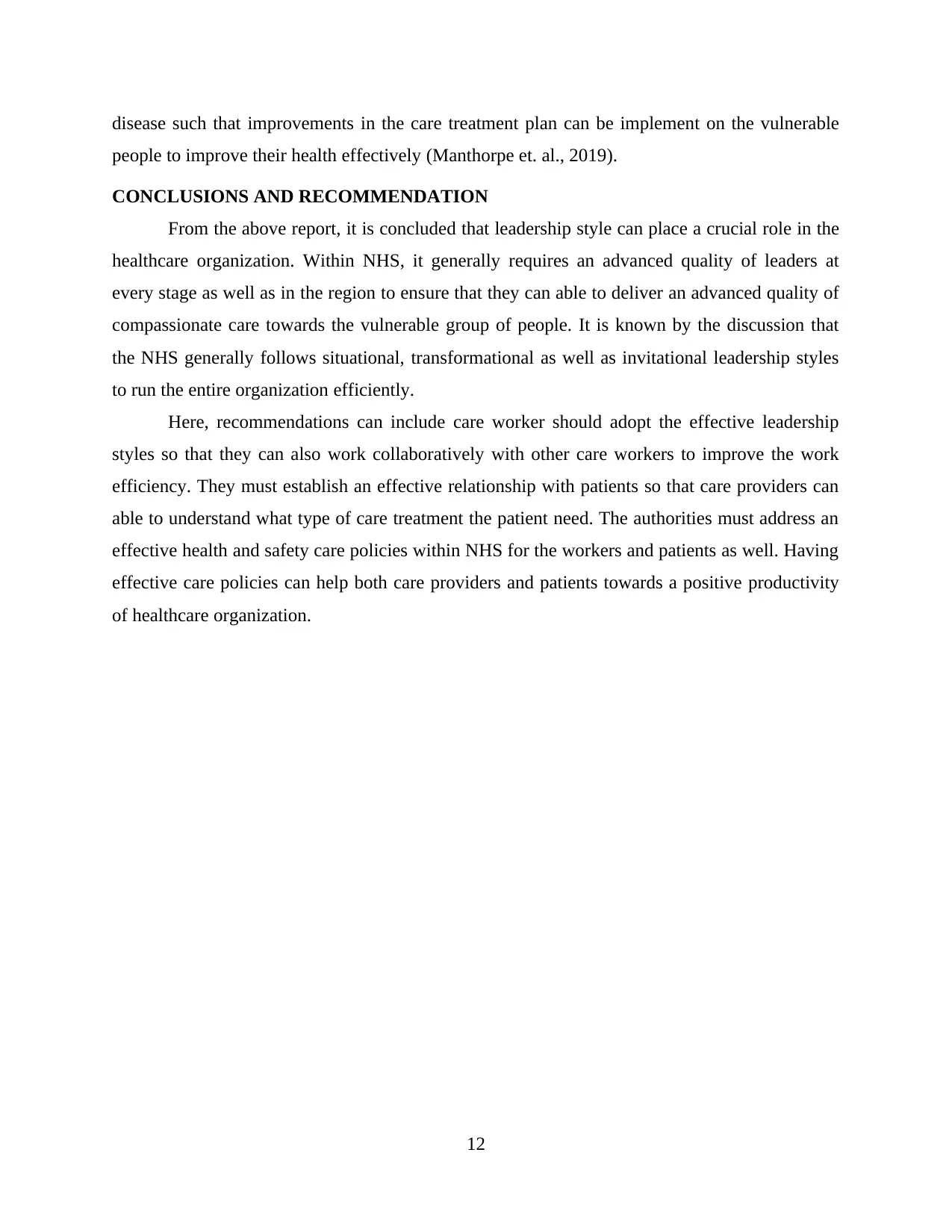
disease such that improvements in the care treatment plan can be implement on the vulnerable
people to improve their health effectively (Manthorpe et. al., 2019).
CONCLUSIONS AND RECOMMENDATION
From the above report, it is concluded that leadership style can place a crucial role in the
healthcare organization. Within NHS, it generally requires an advanced quality of leaders at
every stage as well as in the region to ensure that they can able to deliver an advanced quality of
compassionate care towards the vulnerable group of people. It is known by the discussion that
the NHS generally follows situational, transformational as well as invitational leadership styles
to run the entire organization efficiently.
Here, recommendations can include care worker should adopt the effective leadership
styles so that they can also work collaboratively with other care workers to improve the work
efficiency. They must establish an effective relationship with patients so that care providers can
able to understand what type of care treatment the patient need. The authorities must address an
effective health and safety care policies within NHS for the workers and patients as well. Having
effective care policies can help both care providers and patients towards a positive productivity
of healthcare organization.
12
people to improve their health effectively (Manthorpe et. al., 2019).
CONCLUSIONS AND RECOMMENDATION
From the above report, it is concluded that leadership style can place a crucial role in the
healthcare organization. Within NHS, it generally requires an advanced quality of leaders at
every stage as well as in the region to ensure that they can able to deliver an advanced quality of
compassionate care towards the vulnerable group of people. It is known by the discussion that
the NHS generally follows situational, transformational as well as invitational leadership styles
to run the entire organization efficiently.
Here, recommendations can include care worker should adopt the effective leadership
styles so that they can also work collaboratively with other care workers to improve the work
efficiency. They must establish an effective relationship with patients so that care providers can
able to understand what type of care treatment the patient need. The authorities must address an
effective health and safety care policies within NHS for the workers and patients as well. Having
effective care policies can help both care providers and patients towards a positive productivity
of healthcare organization.
12
Paraphrase This Document
Need a fresh take? Get an instant paraphrase of this document with our AI Paraphraser
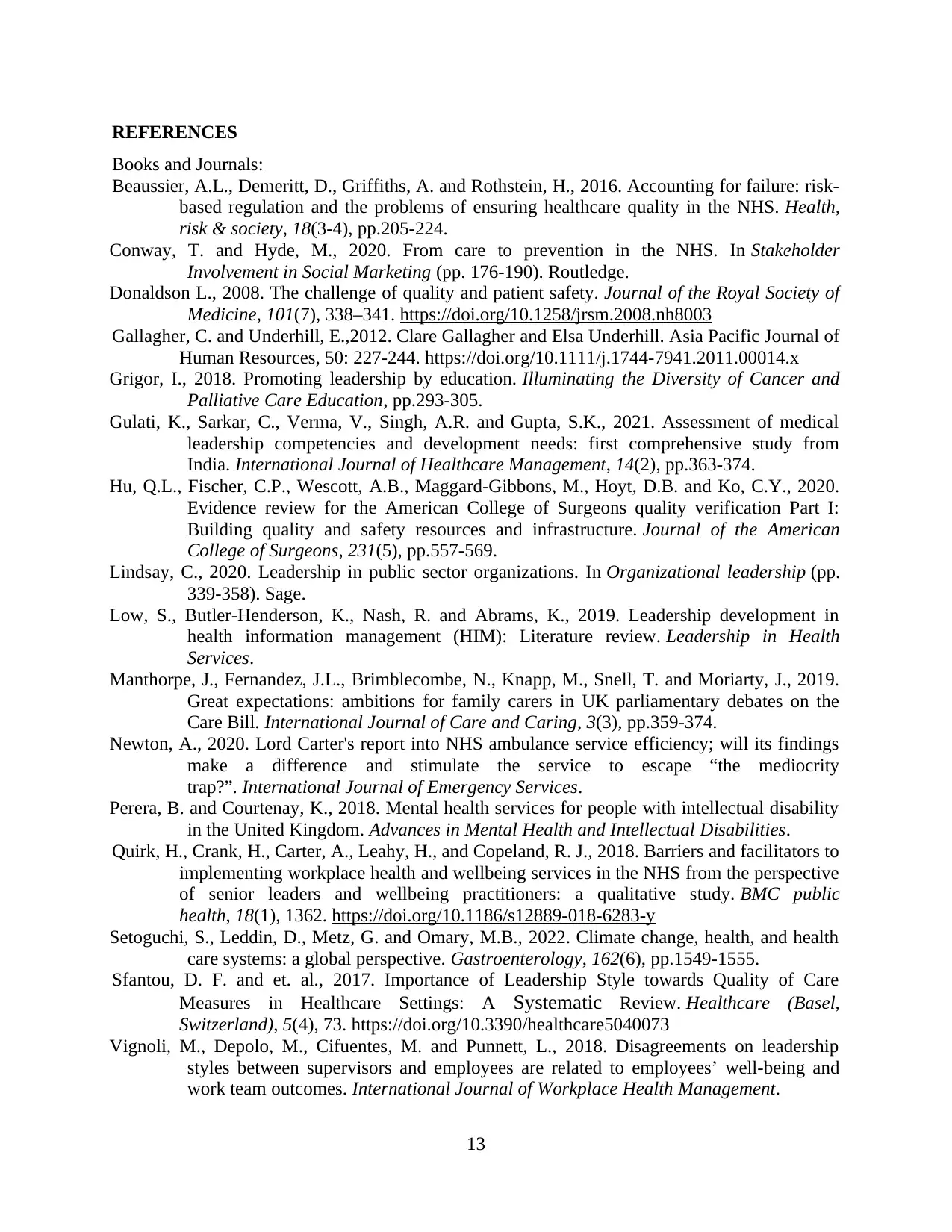
REFERENCES
Books and Journals:
Beaussier, A.L., Demeritt, D., Griffiths, A. and Rothstein, H., 2016. Accounting for failure: risk-
based regulation and the problems of ensuring healthcare quality in the NHS. Health,
risk & society, 18(3-4), pp.205-224.
Conway, T. and Hyde, M., 2020. From care to prevention in the NHS. In Stakeholder
Involvement in Social Marketing (pp. 176-190). Routledge.
Donaldson L., 2008. The challenge of quality and patient safety. Journal of the Royal Society of
Medicine, 101(7), 338–341. https://doi.org/10.1258/jrsm.2008.nh8003
Gallagher, C. and Underhill, E.,2012. Clare Gallagher and Elsa Underhill. Asia Pacific Journal of
Human Resources, 50: 227-244. https://doi.org/10.1111/j.1744-7941.2011.00014.x
Grigor, I., 2018. Promoting leadership by education. Illuminating the Diversity of Cancer and
Palliative Care Education, pp.293-305.
Gulati, K., Sarkar, C., Verma, V., Singh, A.R. and Gupta, S.K., 2021. Assessment of medical
leadership competencies and development needs: first comprehensive study from
India. International Journal of Healthcare Management, 14(2), pp.363-374.
Hu, Q.L., Fischer, C.P., Wescott, A.B., Maggard-Gibbons, M., Hoyt, D.B. and Ko, C.Y., 2020.
Evidence review for the American College of Surgeons quality verification Part I:
Building quality and safety resources and infrastructure. Journal of the American
College of Surgeons, 231(5), pp.557-569.
Lindsay, C., 2020. Leadership in public sector organizations. In Organizational leadership (pp.
339-358). Sage.
Low, S., Butler-Henderson, K., Nash, R. and Abrams, K., 2019. Leadership development in
health information management (HIM): Literature review. Leadership in Health
Services.
Manthorpe, J., Fernandez, J.L., Brimblecombe, N., Knapp, M., Snell, T. and Moriarty, J., 2019.
Great expectations: ambitions for family carers in UK parliamentary debates on the
Care Bill. International Journal of Care and Caring, 3(3), pp.359-374.
Newton, A., 2020. Lord Carter's report into NHS ambulance service efficiency; will its findings
make a difference and stimulate the service to escape “the mediocrity
trap?”. International Journal of Emergency Services.
Perera, B. and Courtenay, K., 2018. Mental health services for people with intellectual disability
in the United Kingdom. Advances in Mental Health and Intellectual Disabilities.
Quirk, H., Crank, H., Carter, A., Leahy, H., and Copeland, R. J., 2018. Barriers and facilitators to
implementing workplace health and wellbeing services in the NHS from the perspective
of senior leaders and wellbeing practitioners: a qualitative study. BMC public
health, 18(1), 1362. https://doi.org/10.1186/s12889-018-6283-y
Setoguchi, S., Leddin, D., Metz, G. and Omary, M.B., 2022. Climate change, health, and health
care systems: a global perspective. Gastroenterology, 162(6), pp.1549-1555.
Sfantou, D. F. and et. al., 2017. Importance of Leadership Style towards Quality of Care
Measures in Healthcare Settings: A Systematic Review. Healthcare (Basel,
Switzerland), 5(4), 73. https://doi.org/10.3390/healthcare5040073
Vignoli, M., Depolo, M., Cifuentes, M. and Punnett, L., 2018. Disagreements on leadership
styles between supervisors and employees are related to employees’ well-being and
work team outcomes. International Journal of Workplace Health Management.
13
Books and Journals:
Beaussier, A.L., Demeritt, D., Griffiths, A. and Rothstein, H., 2016. Accounting for failure: risk-
based regulation and the problems of ensuring healthcare quality in the NHS. Health,
risk & society, 18(3-4), pp.205-224.
Conway, T. and Hyde, M., 2020. From care to prevention in the NHS. In Stakeholder
Involvement in Social Marketing (pp. 176-190). Routledge.
Donaldson L., 2008. The challenge of quality and patient safety. Journal of the Royal Society of
Medicine, 101(7), 338–341. https://doi.org/10.1258/jrsm.2008.nh8003
Gallagher, C. and Underhill, E.,2012. Clare Gallagher and Elsa Underhill. Asia Pacific Journal of
Human Resources, 50: 227-244. https://doi.org/10.1111/j.1744-7941.2011.00014.x
Grigor, I., 2018. Promoting leadership by education. Illuminating the Diversity of Cancer and
Palliative Care Education, pp.293-305.
Gulati, K., Sarkar, C., Verma, V., Singh, A.R. and Gupta, S.K., 2021. Assessment of medical
leadership competencies and development needs: first comprehensive study from
India. International Journal of Healthcare Management, 14(2), pp.363-374.
Hu, Q.L., Fischer, C.P., Wescott, A.B., Maggard-Gibbons, M., Hoyt, D.B. and Ko, C.Y., 2020.
Evidence review for the American College of Surgeons quality verification Part I:
Building quality and safety resources and infrastructure. Journal of the American
College of Surgeons, 231(5), pp.557-569.
Lindsay, C., 2020. Leadership in public sector organizations. In Organizational leadership (pp.
339-358). Sage.
Low, S., Butler-Henderson, K., Nash, R. and Abrams, K., 2019. Leadership development in
health information management (HIM): Literature review. Leadership in Health
Services.
Manthorpe, J., Fernandez, J.L., Brimblecombe, N., Knapp, M., Snell, T. and Moriarty, J., 2019.
Great expectations: ambitions for family carers in UK parliamentary debates on the
Care Bill. International Journal of Care and Caring, 3(3), pp.359-374.
Newton, A., 2020. Lord Carter's report into NHS ambulance service efficiency; will its findings
make a difference and stimulate the service to escape “the mediocrity
trap?”. International Journal of Emergency Services.
Perera, B. and Courtenay, K., 2018. Mental health services for people with intellectual disability
in the United Kingdom. Advances in Mental Health and Intellectual Disabilities.
Quirk, H., Crank, H., Carter, A., Leahy, H., and Copeland, R. J., 2018. Barriers and facilitators to
implementing workplace health and wellbeing services in the NHS from the perspective
of senior leaders and wellbeing practitioners: a qualitative study. BMC public
health, 18(1), 1362. https://doi.org/10.1186/s12889-018-6283-y
Setoguchi, S., Leddin, D., Metz, G. and Omary, M.B., 2022. Climate change, health, and health
care systems: a global perspective. Gastroenterology, 162(6), pp.1549-1555.
Sfantou, D. F. and et. al., 2017. Importance of Leadership Style towards Quality of Care
Measures in Healthcare Settings: A Systematic Review. Healthcare (Basel,
Switzerland), 5(4), 73. https://doi.org/10.3390/healthcare5040073
Vignoli, M., Depolo, M., Cifuentes, M. and Punnett, L., 2018. Disagreements on leadership
styles between supervisors and employees are related to employees’ well-being and
work team outcomes. International Journal of Workplace Health Management.
13
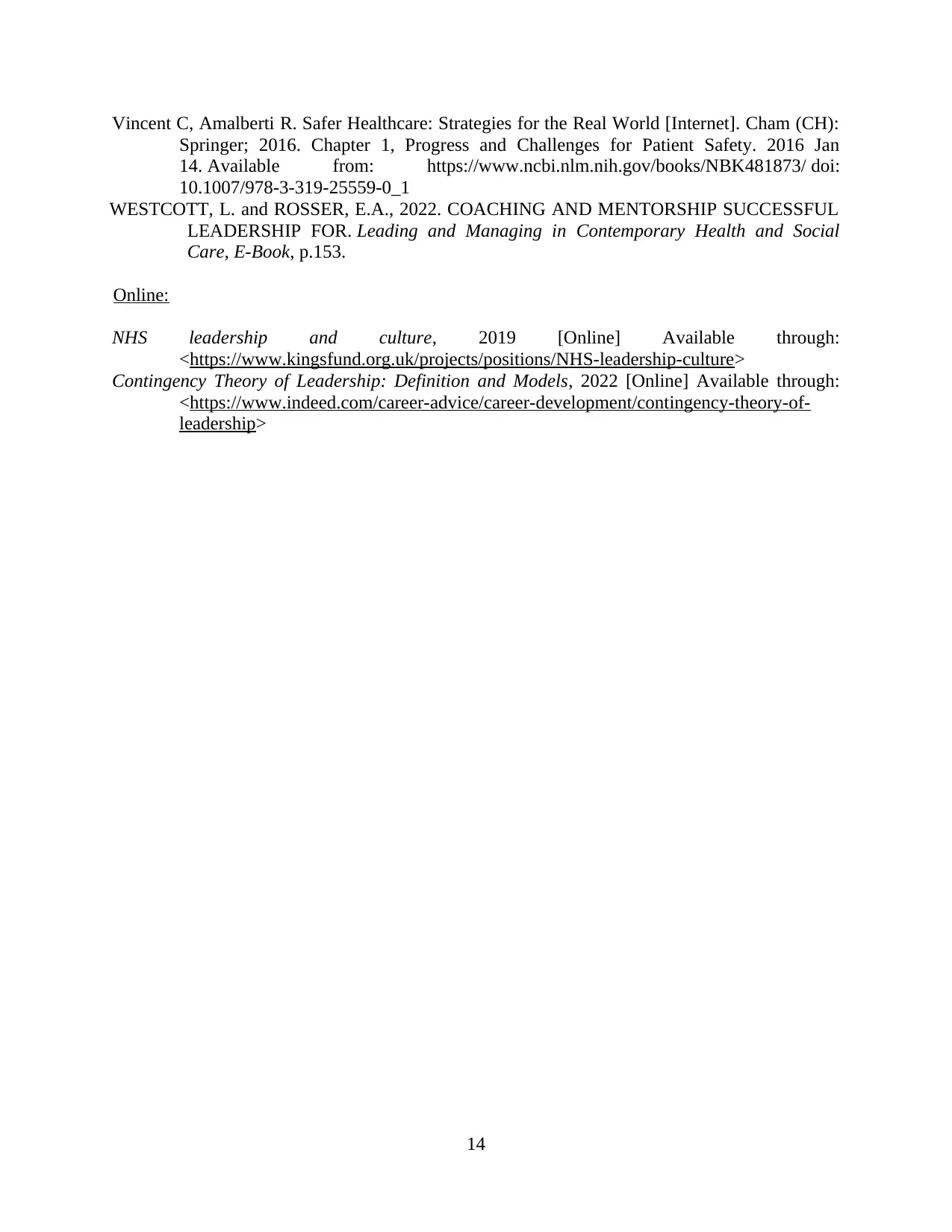
Vincent C, Amalberti R. Safer Healthcare: Strategies for the Real World [Internet]. Cham (CH):
Springer; 2016. Chapter 1, Progress and Challenges for Patient Safety. 2016 Jan
14. Available from: https://www.ncbi.nlm.nih.gov/books/NBK481873/ doi:
10.1007/978-3-319-25559-0_1
WESTCOTT, L. and ROSSER, E.A., 2022. COACHING AND MENTORSHIP SUCCESSFUL
LEADERSHIP FOR. Leading and Managing in Contemporary Health and Social
Care, E-Book, p.153.
Online:
NHS leadership and culture, 2019 [Online] Available through:
<https://www.kingsfund.org.uk/projects/positions/NHS-leadership-culture>
Contingency Theory of Leadership: Definition and Models, 2022 [Online] Available through:
<https://www.indeed.com/career-advice/career-development/contingency-theory-of-
leadership>
14
Springer; 2016. Chapter 1, Progress and Challenges for Patient Safety. 2016 Jan
14. Available from: https://www.ncbi.nlm.nih.gov/books/NBK481873/ doi:
10.1007/978-3-319-25559-0_1
WESTCOTT, L. and ROSSER, E.A., 2022. COACHING AND MENTORSHIP SUCCESSFUL
LEADERSHIP FOR. Leading and Managing in Contemporary Health and Social
Care, E-Book, p.153.
Online:
NHS leadership and culture, 2019 [Online] Available through:
<https://www.kingsfund.org.uk/projects/positions/NHS-leadership-culture>
Contingency Theory of Leadership: Definition and Models, 2022 [Online] Available through:
<https://www.indeed.com/career-advice/career-development/contingency-theory-of-
leadership>
14
1 out of 15
Related Documents
Your All-in-One AI-Powered Toolkit for Academic Success.
+13062052269
info@desklib.com
Available 24*7 on WhatsApp / Email
![[object Object]](/_next/static/media/star-bottom.7253800d.svg)
Unlock your academic potential
© 2024 | Zucol Services PVT LTD | All rights reserved.





